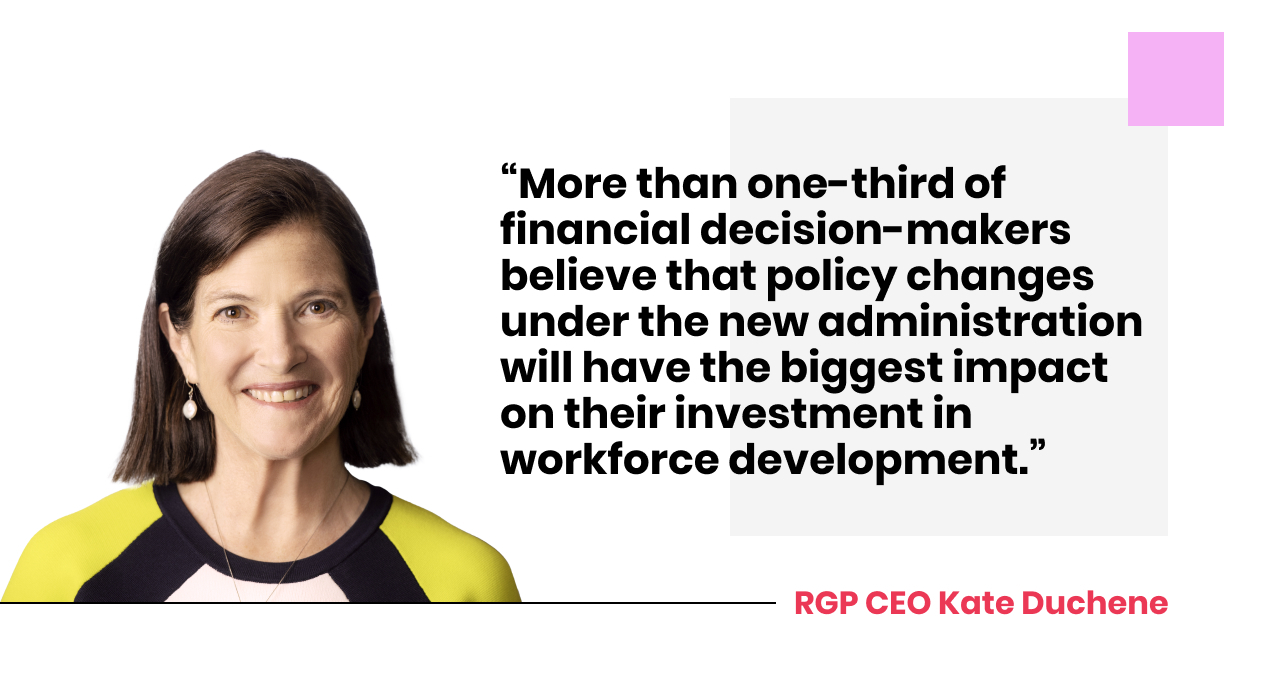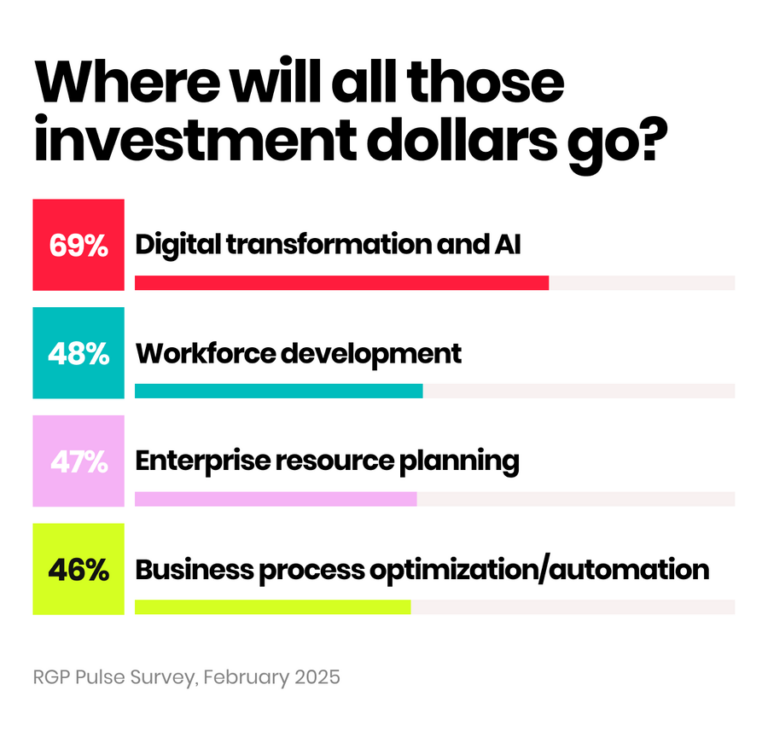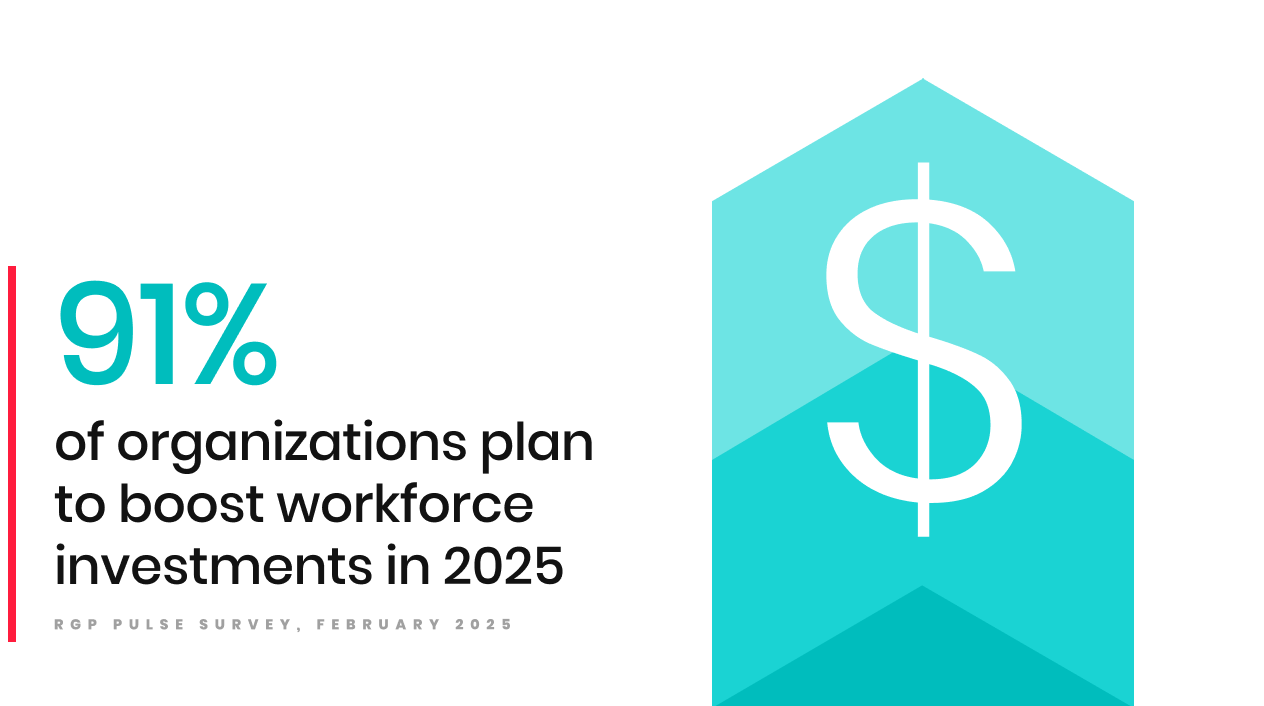February 11, 2025 • 3 Min Read
U.S. business leaders remain committed to increasing workforce investment in 2025, according to our Q1 Transformation Barometer survey. Of the 201 financial decision-makers we surveyed, 91% reported that their organization is planning to increase overall investment in workforce strategy development in the next 12 months.1

Top factors influencing investment priorities and workforce strategy decisions include interest rate cuts, widening skills gaps, and AI investments.
“We’re seeing constant shifts in how companies are aligning their workforce priorities,” said RGP CEO Kate Duchene. “More than one-third of financial decision-makers believe that policy changes under the new administration will have the biggest impact on their investment in workforce development, yet leaders we surveyed were more concerned by employee retention and engagement, growing urgency to better leverage AI, and hiring challenges.”
Kate believes these factors will continue to shape the way businesses prioritize their workforce investments in the year ahead.
Interest Rate Cuts Release the Investment Dam
Investments tied to interest rate cuts in 2024 are now poised to begin flowing, with 79% of survey respondents anticipating increased investments by the end of 2025 and 58% expecting them to begin within the first six months of the year.

How Digital Transformation & AI Are Shaping Business Strategy
With more than two-thirds of companies investing in digital transformation and AI, business strategy and digital transformation priorities are closely intertwined. But which is in the driver’s seat?
Respondents from 42% of organizations surveyed indicated that digital transformation priorities are not just a primary focus of the business strategy but are actually shaping it. Conversely, 33% said business strategy was the driving force.
Digital transformation also tops the list of operational areas that organizations will prioritize for AI investments over the next 12 months:
- Digital transformation: 62%
- IT operations and security: 61%
- Product development and innovation: 52%
- Customer service and support: 52%
- Risk management and compliance: 51%
- Finance and accounting: 48%
- HR and talent management: 42%
Getting those priorities right is key—62% of respondents cited this as a critical success factor for successful AI implementations. Only two factors ranked higher: ensuring data is clean and accurate (73%) and implementing extensive training and upskilling (69%).
Respondents cited customer service as the function they expect to be impacted most by their organization’s AI investments over the next 12 months. A vast majority (82%) believe AI will have a significant positive impact on customer experience (CX) in their organization over the next year.
In our recent Visionary Voices interview, Microsoft Cloud and AI Leader Lili Cheng advised organizations to be open about how AI can benefit them, think beyond the obvious, low-hanging fruit, and invest accordingly. “The most senior people in an organization need to recognize that AI isn’t just about execution but also needs to be part of their strategic planning,” she said.

Widening Skills Gaps Build Momentum for a Dynamic Workforce™
More than 40% of organizations reported increased difficulty acquiring new skillsets over the past year. So it’s not surprising that widening skills gaps continue to have a significant impact on investment priorities. And the percentage of companies feeling the effects is still growing.
- 26% said their organization is currently experiencing widening skills gaps—up from 17% in our October survey.
- 63% expect their organization’s skills gaps to increase in 2025.
- 27% reported that their organization has narrowed its skills gaps with AI and other digital tools.
These gaps highlight the need for a more Dynamic Workforce. Of the 91% of organizations that plan to boost workforce investments in 2025, nearly half (46%) remain focused on reskilling and upskilling existing employees, while 22% plan to increase investment in outside talent, and 18% expect to increase investment in internal headcount.
1 The findings are based on a poll of 201 U.S. full-time professionals conducted January 2nd through the 9th in 2025. The poll consisted of respondents at the director level or above who influence finance decision-making at organizations with $500 million or more in annual revenue.
